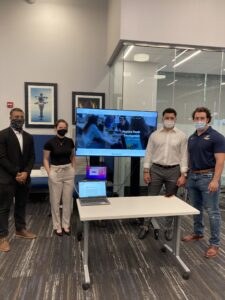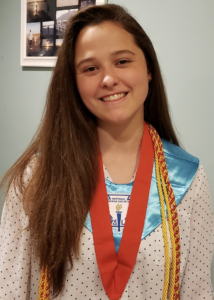Research for Impact with ConnectiKids at the Liberal Arts Action Lab
In fall 2021, when I saw the opportunity to collaborate with a youth service organization in the Liberal Arts Action Lab, I knew I had to apply. I ended up working on the Positive Youth Development Project with ConnectiKids this past spring, where I participated in conducting research on the organization’s long-term impact. The project fit my academic interest in public service and education and allowed me to learn about research methods and collaboration. Our work also had a direct impact on our community partners at ConnectiKids, who have since used our deliverables in their internal reporting and communications.
ConnectiKids is a nonprofit positive youth development program that utilizes mentorship, tutorial, and enrichment programming to help participants grow academically and socially. Despite evidence of success in the short-term, ConnectiKids had no reportable data to support that their participants’ successes continued once they left the program. Our goal was to provide them with evidence to emphasize the program’s long-term value for well-being and educational attainment.

We were able to do just that. Our analysis showed that past participants experienced a higher college attendance rate when compared to Hartford averages, a general sense of stability and good mental health in their early adulthood, and years of genuine mentorship and social support. Along with our final presentation, we shared these results in a report, website, and collection of personal anecdotes from past youth participants. Kaleitha Brown, Director of Development at ConnectiKids, has already used the report internally and is planning to share findings externally. She describes, “We shared a report of our Action Lab meetings with the staff and board as the project progressed and it really lit a fire under our organization. Something that had seemed insurmountable for years suddenly became a possibility.” ConnectiKids is now able to use the findings to bolster their web presence and their grant and funding proposals.
When the Action Lab project kicked off in February 2022, the first thing we did was meet with representatives of the program, including Kaleitha Brown and Kiera Steele, who would be our contacts for the length of the project. I remember thinking how impressed I was with their communication and management style and how inspired I was to see them in their roles as directors of a nonprofit, something I could see myself doing in the future. The early conversations we had about the project were really meaningful. Coupled with Dr. Emily Cummins’ teachings about participatory research and cultural humility, they led us to center ConnectiKids’ goals and needs in the project.
We then moved on to data collection, relying on the program’s existing documentation to form a sample of participants who had been part of ConnectiKids in the elementary and middle school programs between 2002 and 2009. In regular conversation with our partners, we discussed how to best measure success by ConnectiKids standards, our standards, and the standards of potential grantors. We decided on three phases of data collection, two quantitative and one qualitative.The first phase involved database analysis, the second consisted of survey distribution, and in the third phase we conducted interviews. Daniel Douglas, Director of Social Science Research and Lecturer in Sociology at Trinity, helped us with the first phase of database analysis and everything numerical along the way. Dr. Douglas encouraged us to utilize the National Student Clearinghouse (NSC), a leading provider of educational reporting and data exchange, to verify college attendance and completion rates for our sample.
In addition to this secondary data analysis, we collected original data through community outreach. With the guiding hand of our group’s professor, Dr. Tricia George, we created and disseminated a survey and conducted interviews with past ConnectiKids participants. Anyone who has done grassroots outreach knows that you have to be adaptable. We learned that lesson early on when the contacts for our sample were all out-of-service numbers. When cold calling didn’t work we made the switch to social media outreach and had much better luck. Kiera Steele says, “We appreciate the group’s efforts in using different tactics to get in contact with our alumni. It was great, as they had ideas we had not thought of.” For us, it was good exposure to the problem solving and communication skills necessary for community organizing.

We had a small number of respondents, but they were all eager to help and engage in further conversation. One of my most impactful moments during the semester was from an interview with a former participant. The person I was speaking to was so joyful; their energy and love for the program was contagious. They were pursuing a social work degree and cited ConnectiKids as their inspiration. They had such a formative time in their youth that they committed themselves to a life of similar work. It was inspiring to hear their story and their words of praise for the program.
All of these data sources enabled us to capture a holistic, multi-dimensional picture of ConnectiKids’ long-term impacts. It was a truly mutually beneficial process. Rashaud Conway ‘23, one of my team members, reflected that “[the project] allows students to look outside of campus and engage with the Greater Hartford community, while also giving students hands-on research experience.”
This past semester opened doors for me in a lot of ways. I gained a new appreciation for the research process and was given an opportunity to network in a community of people trying to make a difference. Thanks to the contacts I acquired, I was able to line up an impactful, public health-based summer internship with Cross Sector Consulting.
Beyond personal gains, what sits with me most today is the expression on Kaleitha Brown’s face the night of our presentation. She was so happy to see our work formalized and so proud of the program successes that it highlighted. Of the final presentation, Ms. Brown reflects, “It was a busy time of year for us and I was the only one from our team able to attend, and arrived late on top of that. When I walked in, our research team was in the middle of presenting their project to a guest. I stood in the back of the audience and listened as our team of students expertly explained our mission as if they had worked at ConnectiKids for years, the research project, and their findings. It was obvious that they were proud of their work, and that is a great thing to see in young professionals. When they noticed I was there, they ushered me over and excitedly repeated the entire presentation with passion and confidence from beginning to end. I felt like a proud mom! Overall, we couldn’t be more thankful to the research team and the entire LAAL program for this amazing opportunity that will have such long-lasting benefits on the children we serve and the overall community!” For me, it was incredibly powerful to be able to have an impact on Ms. Brown’s work and to contribute to the continued success of ConnectiKids.
